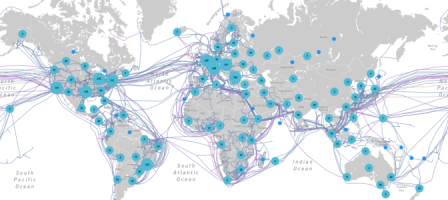What are the Internet infrastructures?¶
Authors and date
- Submitted on: March 9th 2021
- Benjamin Ninassi; Research engineer ; Inria
Introduction¶
Watching a movie in streaming, booking a train ticket at any time, remotely adjusting the temperature of your home or checking the traffic before taking your car...little by little, so many actions became possible since the 80s 1 thanks to the Internet. This open and accessible global computer network allows the transfer of information in different forms from one end of the planet to the other, almost immediately. The Internet also allows web browsing, among many other uses. But how is this information delivered?
We will approach in this article the succession of devices necessary to the functioning of the Internet, through its various uses. Used protocols or software layers are already approached in various other educational resources and will not be mentionned here.
The local network¶
One of the most common uses of the Internet is web browsing. Browsing is most often the manipulation of a device by a human, from a building. These devices can be a computer (desktop or laptop), a smartphone, a tablet, a television, a video game console, etc. Other everyday objects also offer web interfaces, such as printers or connected thermostats.
These devices are able to communicate with each other directly via the local network, for example the one you have at home, which is most of the time managed by your Internet box. The communication can also be managed by a network device allowing the wiring of the different rooms of your house, called a switch. Your browsing device is connected to this network by a cable (usually called RJ45 2 in reference to the name of its connectors) or via Wi-Fi 3. It is also possible that your home contains PLC boxes 4 allowing the transfer of information via your electrical network, as well as Wi-Fi repeaters depending on the size of your home.
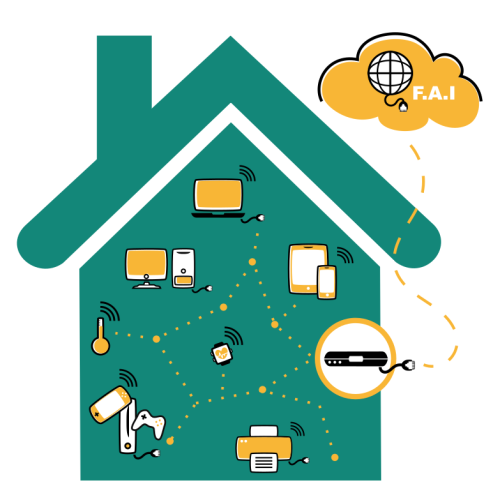
Thus, before leaving your home, the data from your computer may have already passed through multiple network devices before finally reaching the box provided by your Internet Service Provider (hereafter called ISP). This is where the data will leave your local network to start its journey on the Internet.
The interconnection to the Internet¶
The information will then transit on the different network equipments of your Internet access provider (ISP), starting with your box. These network devices are connected to each other, most of the time by optical or copper cables, like the traditional phone networks carrying ADSL 5. These equipments are of very different natures: we will find a few kilometers from the houses, the multiplexers (commonly called DSLAM for Digital Subscriber Line Access Multiplexer) to which the Internet boxes are directly connected. Further away, the ISP data processing centers will contain devices allowing the interconnection of the different ISPs' networks, both national and international. Some equipment is used to repeat signals, allowing information to travel greater distances without being altered; others to send the information to the right destination, and still others to filter the signals. These filters can be physical, for example to separate phone calls from Internet data on an ADSL line, or software (such as firewalls) to implement for example censorship policies 6.
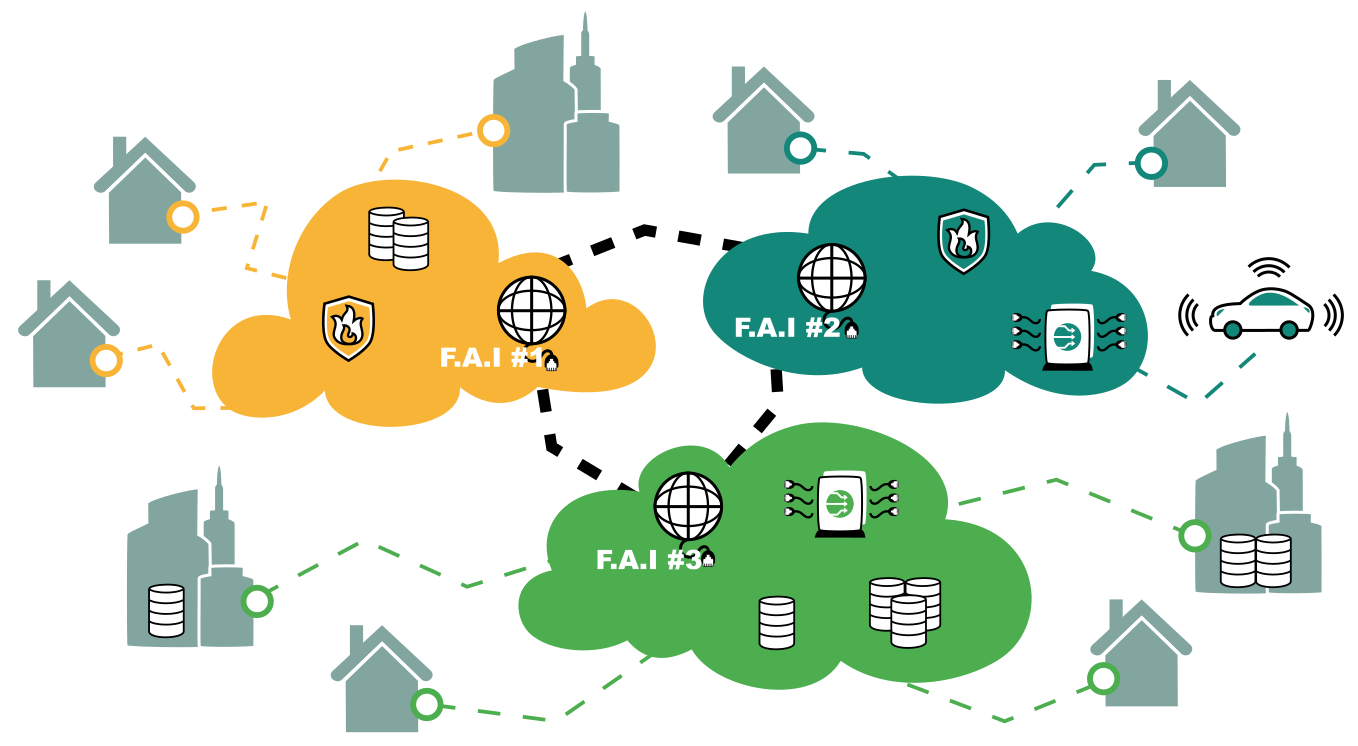
Depending on the nature of the equipment, for example a fiber or ADSL box, the information will circulate on different infrastructures and at different speeds. This speed is commonly characterized by the network transfer speed, which represents a quantity of data transmitted per unit of time. It is called download speed when the transfer is from the internet to your device, and upload speed when it comes from your device to the internet. Theses speeds are dependent on the nature of the materials and technologies used, as well as the saturation of the infrastructure that the information will travel over from end to end. ISPs highlight the speeds between your box and their data center, but the actual speeds you experience while surfing the web will generally be much lower: it will depend on the lowest speed encountered on all the infrastructures that the data will use.
All these equipments connect not only individuals to each other, but also companies and all the data centers hosting online digital services.
This physical web is made up of a succession of network equipments, data centers, cables and other means of transferring information and all the devices connected to the Internet.
A great heterogeneity of accesses¶
The box connected to the network by a copper cable or optical fiber is not the only way to connect to the Internet. Apart from Wi-Fi, smartphones use other wireless networks (3G, 4G, 5G, ...) that depend on another type of infrastructure: microwave antennas, which allow information to travel through the air. It is also possible to connect a home using this same technology, via a 4G box. Some technical sites located in remote areas communicate exclusively by microwave. It is also possible to connect your home to the Internet by satellite, this is the purpose for example of the Starlink program 7 of SpaceX which regularly sends large quantities of new satellites into orbit.
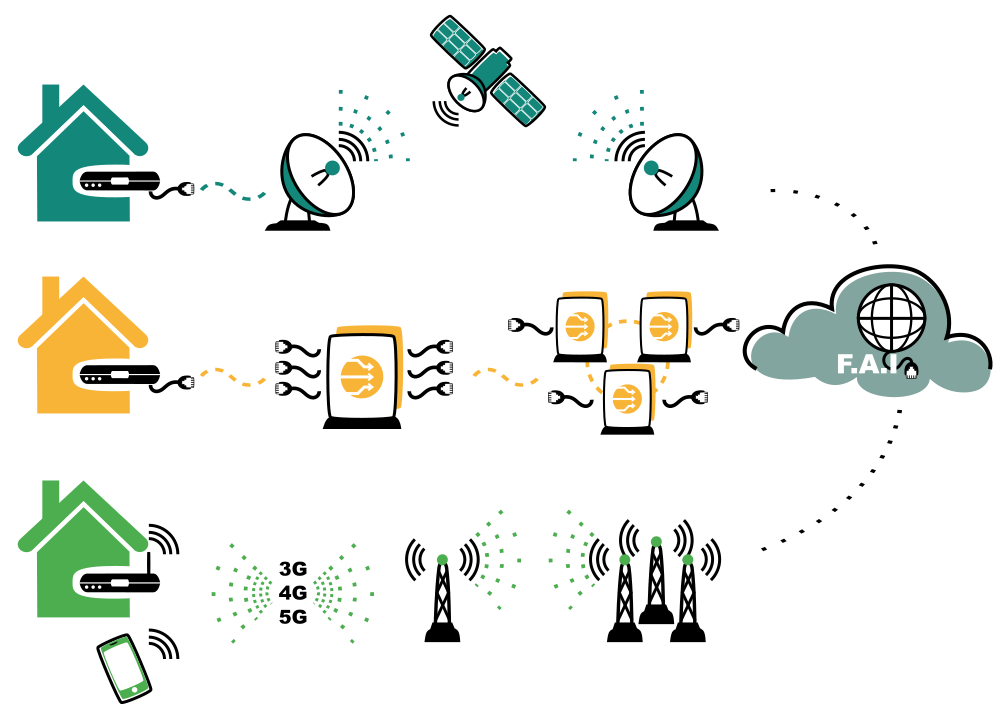
Moreover, not all Internet users are human: there is now a wide variety of devices that communicates through this network all the time. In our homes, the most common is the printer, which is now usually integrated into the local network alongside our computers. It is also possible to connect your watch, the thermostat of your heating system to regulate it remotely, home automation to turn on or off lights and open shutters from your smartphone, surveillance equipment such as an alarm, motion sensors, etc.
In addition to all this devices, there is a growing range of connected objects. This is the Internet of Things 8. Connected vehicles, sensors in Smart Cities (smart street lights, dynamic traffic signs, surveillance cameras, etc.), environmental sensors, connected health devices... these are all revolutions in practices that considerably increase communications between machines, called M2M (Machine to Machine)9. These evolutions of practices have a strong impact on the Internet infrastructures, and on their evolution like the deployment of 5G .
How much is the Internet?¶
How many devices make up the Internet? How many men and women work every day to allow it to exist? What is its real environmental impact? None of these questions, which may seem simple, have a precise answer. Several factors make it very difficult to count the number of devices, and globally to measure the activity that makes the Internet possible:
The variety of equipment types and manufacturers: we don't know how many devices and what types are manufactured
The heterogeneity of the equipments used, as well as the multitude of manufacturers and their nationalities, makes attempts to aggregate informations from the production centers very uncertain. Moreover, the categorization of devices is made even more difficult as some of them perform several functions at the same time and have several network interfaces.
Lack of activity traceability: we don't know which devices are actually connected to the Internet, are used for other purposes or are sleeping in closets
All equipments that can be connected to the Internet may have other uses, for example within private or professional networks. Indeed, not all networks are connected to the Internet, but the devices used are identical. Moreover, some of these equipments are waiting to be connected, or stored in case of need.
Lack of end-of-life traceability: we don't know which devices are still in circulation
No globalized policy for the treatment of the end of life of equipment (the management of WEEE 10 ) exists. It is currently not possible to know whether a device that has been manufactured is still in use or has been thrown away.
The globalization of the Internet: policies are heterogeneous regarding transparency and access to information, and thus to connected devices
Not all countries allow access to all Internet content: some practice censorship for political reasons, others for economic reasons. The Internet is not as transparent and accessible as we think: some parts of the Internet, and therefore some network equipments and data centers, are only accessible from certain geographical areas. For example, even in France you cannot access all the cultural content available on the web due to legal differences between countries, especially regarding copyright and distribution.
The industrial secret: the number of humans implementing the Internet is unknown
The work force needed for the implementation of the infrastructures and the maintenance operations is mostly covered by the industrial secret. Many companies compete for these different markets, most of the time with a rather complex and opaque chain of subcontracting. The management of the buildings and other private infrastructures hosting the equipments, or of the satellites, are just as much a mystery, making it impossible to put a precise number on the environmental impacts of the Internet.
There are nevertheless several studies that attempt to provide some answers to these questions. If the numbers are necessarily estimates based on numerous hypotheses, their order of magnitude nevertheless remains a useful indicator for understanding the materiality of the Internet. According to Cisco11, a leading manufacturer of networking equipment, in 2018 there were:
- 3.9 billion humans connected to the Internet, or 51% of the world's population
- 19.4 billion devices connected to the Internet, 33% of them being IOT
With an observed annual growth in the number of devices of 10%, Cisco's projections for the future announce almost 30 billion connected objects by 2023. The gradual connection of the 49% of the world's population that did not have internet in 2018, as well as the deployment of 5G that will be accompanied by a massive increase of new connected objects, will likely improve this growth and increase this number.
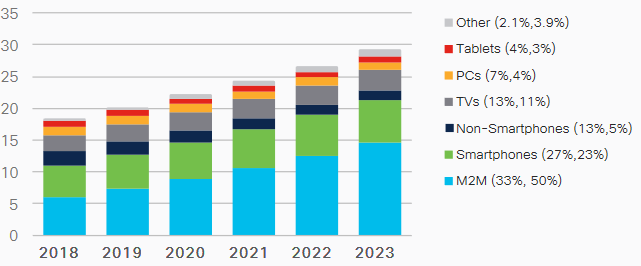
Furthermore, these numbers do not take into account the data centers or network devices that make up the core of the internet, but only its edges.
The participative website Infrapedia 12 proposes a mapping of the main connections and data centers allowing the Internet to be online. This census is based on the good will of professionals to declare and share data, it can unfortunately not be considered as complete. This said, it is an effort of participative construction of knowledge that deserves to be praised.
In 2015, GreenIt.fr published an article 13 attempting the difficult exercise of providing a numerical estimation of the annual global energy footprint of the web, approximated to 1,037 TWh of energy, the equivalent of 40 nuclear power plants. Although the approach is interesting, the data sources and models used in this calculation were unfortunately not shared, making this result unverifiable.
In 2020, ARCEP published its report Achieving Digital Sustainability14 in which is highlighted the important share, estimated between 70% and 80%, of the last network connection segment in energy consumption, namely between the ISP and the user terminal.
Beyond the energy impact, it should also be possible to take into account all the other forms of pollution generated by the entire life cycle of this devices: the depletion of natural resources, water consumption, soil pollution, acidification of aquatic environments, etc.
The Internet also contributes to another form of pollution, through programs like Starlink: the one above our heads, linked to the massive increase in the number of satellites and launches. The European Space Agency 1516 (ESA) is seriously studying this phenomenon which could, in the long run, saturate the orbits.
To go further on the numbers, a concept sheet in this Mooc is dedicated to them 17.
What about the Internet, tomorrow?¶
Making the functioning of the Internet more transparent, all the necessary devices, systematizing the measurements and modelling its environmental impacts are all challenges to be met. The expected growth in the number of connected people, uses and equipments must be anticipated and accompanied by measures to ensure its sustainability. This construction of knowledge and its sharing is crucial to enlight societal choices, such as the launch of major development projects, the renewal of infrastructures or the evolution of regulations. The french new law aimed at informing consumers about the environmental impact of their data consumption and the deployment of 5G are perfect examples.
-
Cisco Annual Internet Report (2018 - 2023): https://www.cisco.com/c/en/us/solutions/collateral/executive-perspectives/annual-internet-report/white-paper-c11-741490.html ↩
-
Frédéric Bordage. Quelle est l’empreinte environnementale du web ? [online]. 12/05/2015. Available at GreenIT site ↩
-
Achieving Digital Sustainability. ARCEP, 15/12/2020. Available on the Arcep website ↩
-
Concept sheet: "The information technologies and the environment in a few numbers"Concept sheet: "The information technologies and the environment in a few numbers" ↩
